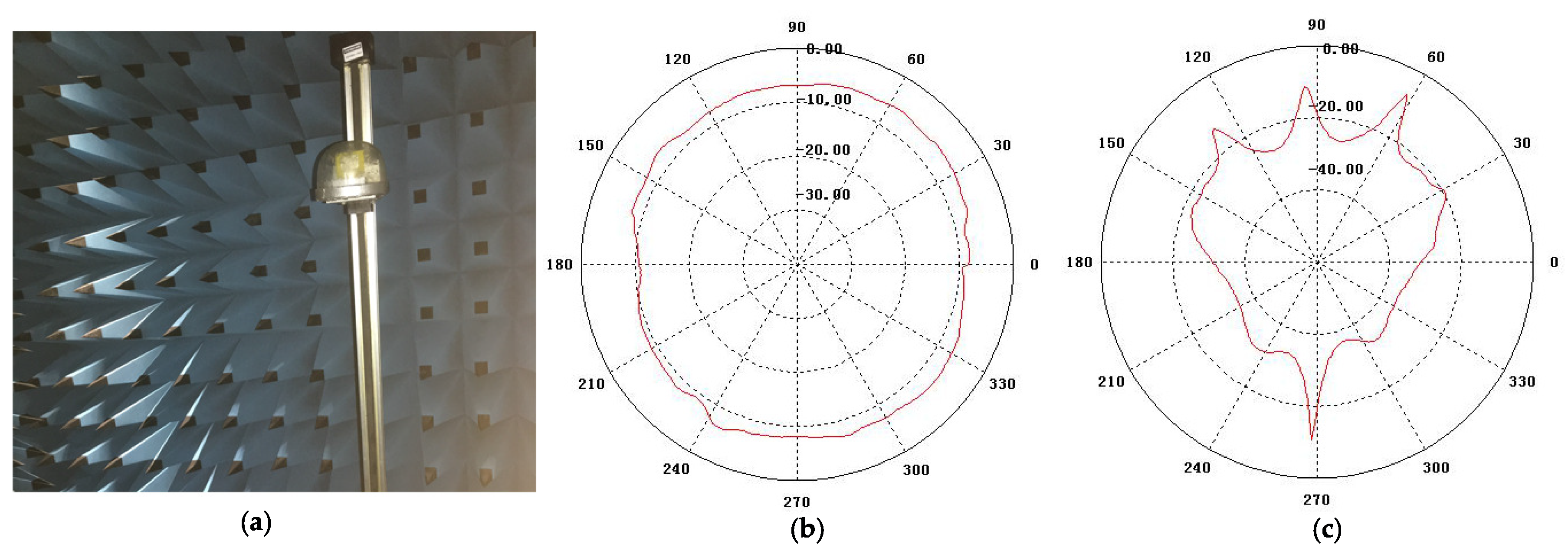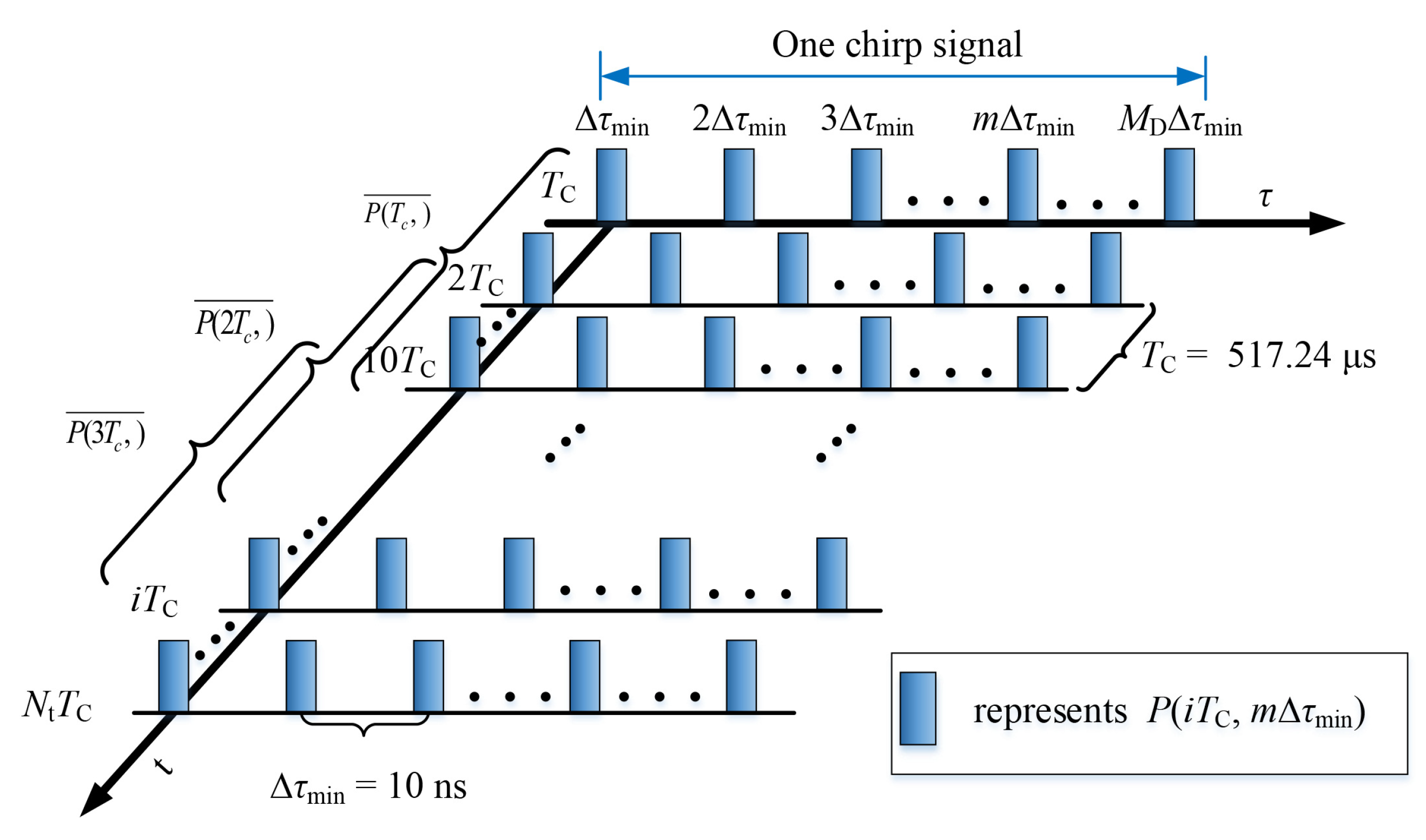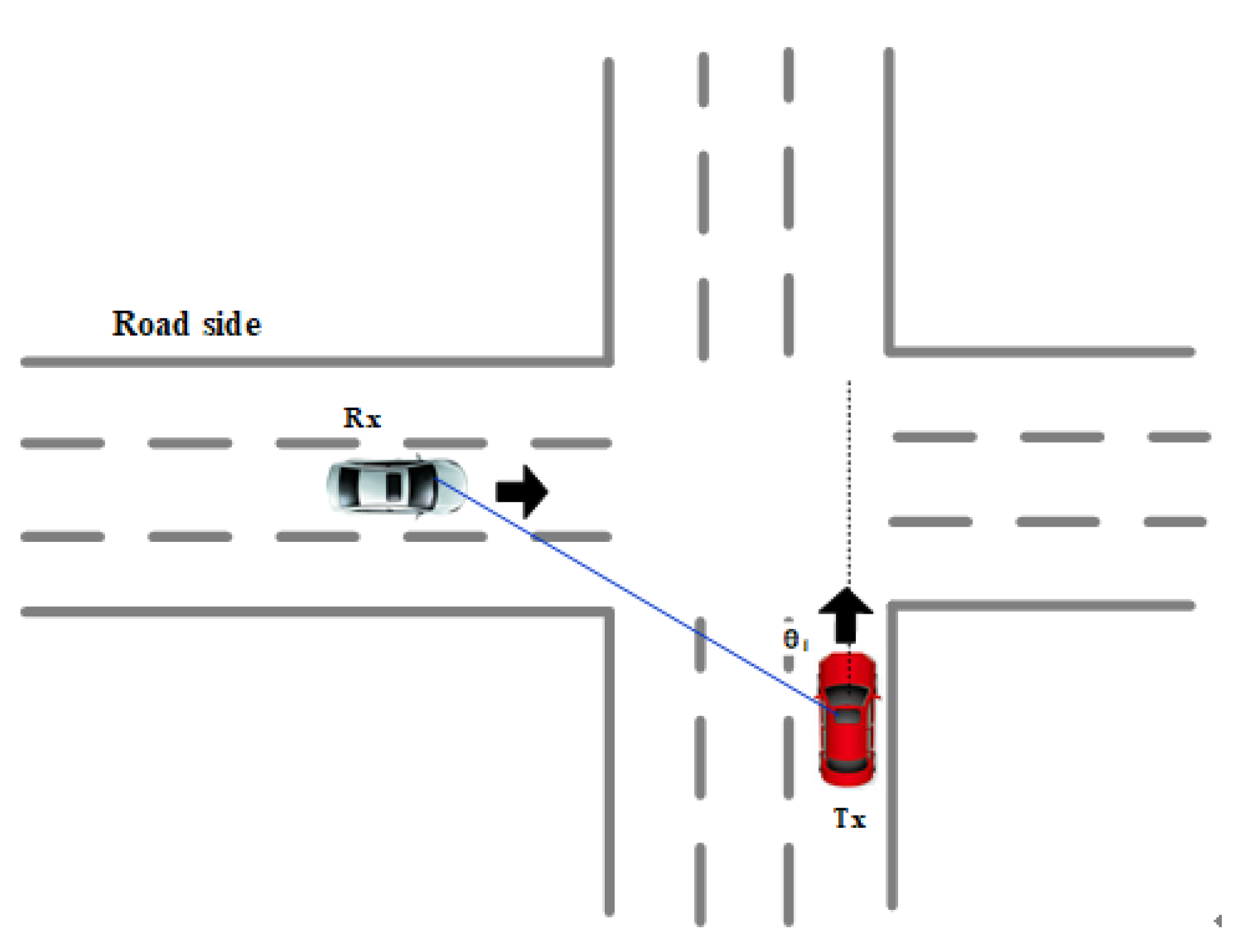Analysis of Non-Stationarity for 5.9 GHz Channel in Multiple Vehicle-to-Vehicle Scenarios
Abstract
:1. Introduction
- We obtained a large amount of high-precision data measured under various road conditions in China. We selected seven scenarios for comparison with each other to explore the effect of surroundings from the measured data. The statistical channel characteristics acquired by continuous measurements are more accurate.
- To determine the influence of relative speed, we select three typical driving directions of two vehicles: the same direction, the perpendicular direction, and the opposite direction, for comparison.
- We compare the characteristics of the PDP in different driving conditions. The differences in the scattering environment in different scenarios can be observed.
- The most important factors affecting the stationary time are the relative speed and the environment. The temporal PDP correlation coefficient is used to explain the non-stationarity phenomenon.
2. Measurements
2.1. Measurement Setup
2.2. Measurement Description
2.2.1. Car-Following Scenarios
2.2.2. Intersection Scenarios
2.2.3. Opposite Traveling Scenarios
3. Local Region of Stationarity Calculation
4. Measurement Evaluation and Data Analysis
4.1. Car-Following Scenarios
4.1.1. Congestion, Low-Speed Scenario
4.1.2. Medium-Speed Scenario
4.1.3. The High-Speed Scenario on the Viaduct
4.2. Intersection Scenarios
4.2.1. Urban Intersection Scenario
4.2.2. Suburban Intersection Scenario
4.3. Opposite Traveling Scenario
4.3.1. Beam Bridge Scenario
4.3.2. Suspension Bridge Scenario
4.4. Statistical Analysis
5. Conclusions
6. Discussion
Author Contributions
Funding
Institutional Review Board Statement
Informed Consent Statement
Data Availability Statement
Acknowledgments
Conflicts of Interest
Abbreviations
| V2V | Vehicle to Vehicle |
| LRS | Local Region of Stationarity |
| PDPs | Power Delay Profiles |
| LoS | Line of Sight |
| NLoS | Non-Line-of-Sight |
| LSF | Local Scattering Function |
| SNR | Signal Noise Ratio |
| MSE | Mean Square Error |
| MPCs | Multi-path Component |
| WSSUS | Wide-Sense Stationary Uncorrelated Scattering |
| CCF | Channel Correlation Function |
| CMD | Correlation Matrix Distance |
| IDFT | Inverse Discrete Fourier Transform |
| CIR | Channel Impulse Response |
| CDF | Cumulative Distribution Function |
References
- Wang, C.-X.; Bian, J.; Sun, J.; Zhang, W.; Zhang, M. A survey of 5G channel measurements and models. IEEE Commun. Surv. Tutor. 2018, 20, 3142–3168. [Google Scholar] [CrossRef]
- Zeadally, S.; Guerrero, J.; Contreras, J. A tutorial survey on vehicle-to-vehicle communications. Telecommun. Syst. 2020, 73, 469–489. [Google Scholar] [CrossRef]
- Arena, F.; Pau, G.; Severino, A. A review on IEEE 802.11 p for intelligent transportation systems. J. Sens. Actuator Netw. 2020, 9, 22. [Google Scholar] [CrossRef]
- Molina-Masegosa, R.; Gozalvez, J. LTE-V for sidelink 5G V2X vehicular communications: A new 5G technology for short-range vehicle-to-everything communications. IEEE Veh. Technol. Mag. 2017, 12, 30–39. [Google Scholar] [CrossRef]
- Pätzold, M. Mobile Radio Channels; John Wiley & Sons: Hoboken, NJ, USA, 2011. [Google Scholar]
- Torrico, S.A.; Lang, R.H. Comparison of physics-based propagation model and measurements in a vegetated residential area at 3.5 GHz and 5.8 GHz. Radio Sci. 2019, 54, 1046–1058. [Google Scholar] [CrossRef]
- Gustafson, C.; Mahler, K.; Bolin, D.; Tufvesson, F. The COST IRACON geometry-based stochastic channel model for vehicle-to-vehicle communication in intersections. IEEE Trans. Veh. Technol. 2020, 69, 2365–2375. [Google Scholar] [CrossRef] [Green Version]
- Chang, H.; Bian, J.; Wang, C.X.; Bai, Z.; Zhou, W.; Aggoune, E.-H.M. 3D Non-Stationary Wideband GBSM for Low-Altitude UAV-to-Ground V2V MIMO Channels. IEEE Access 2019, 7, 70719–70732. [Google Scholar] [CrossRef]
- He, D.; Ai, B.; Guan, K.; Wang, L.; Zhong, Z.; Kürner, T. The design and applications of high-performance ray-tracing simulation platform for 5G and beyond wireless communications: A tutorial. IEEE Commun. Surv. Tutor. 2019, 21, 10–27. [Google Scholar] [CrossRef]
- Leonor, N.R.; Fernandes, T.R.; Sánchez, M.G.; Caldeirinha, R.F.S. A 3D model for millimeter-wave propagation through vegetation media using ray-tracing. IEEE Trans. Antennas Propag. 2019, 67, 431–4318. [Google Scholar] [CrossRef]
- 3GPP TR 38.900. Study on Channel Model for Frequency Bands above 6 GHz. v. 15.0.0. Available online: https://portal.3gpp.org/desktopmodules/Specifications/SpecificationDetails.aspx?specificationId=2991 (accessed on 23 October 2018).
- 3GPP TR 38.901. Study on Channel Model for Frequencies from 0.5 to 100 GHz. v. 14.3.1. Available online: https://portal.3gpp.org/desktopmodules/Specifications/SpecificationDetails.aspx?specificationId=3173 (accessed on 5 March 2017).
- Kampert, E.; Jennings, P.A.; Higgins, M.D. Investigating the V2V millimeter-wave channel near a vehicular headlight in an engine bay. IEEE Commun. Lett. 2018, 22, 1506–1509. [Google Scholar] [CrossRef] [Green Version]
- He, R.; Li, Q.; Ai, B.; Geng, Y.L.; Molisch, A.F.; Kristem, V.; Zhong, Z.; Yu, J. A kernel-power-density-based algorithm for channel multipath components clustering. IEEE Trans. Wirel. Commun. 2017, 16, 7138–7151. [Google Scholar] [CrossRef]
- Serizawa, K.; Tomimoto, K.; Miyashita, M.; Yamaguchi, R. Doppler spectrum evaluation on V2V communications for platooning. IEICE Commun. Express 2019, 8, 184–189. [Google Scholar] [CrossRef]
- Guan, K.; He, D.; Ai, B.; Matolak, D.M.; Wang, Q.; Zhong, Z.; Kuerner, T. 5-GHz Obstructed Vehicle-to-Vehicle Channel Characterization for Internet of Intelligent Vehicles. IEEE Internet Things J. 2019, 6, 100–110. [Google Scholar] [CrossRef]
- Bello, P.A. Characterization of randomly time-variant linear channels. IEEE Trans. Commun. 1963, 11, 360–393. [Google Scholar] [CrossRef] [Green Version]
- Li, Z.; Jiang, Y.; Gao, Y.; Sang, L.; Yang, D. On Buffer-Constrained Throughput of a Wireless-Powered Communication System. IEEE J. Sel. Areas Commun. 2019, 37, 283–297. [Google Scholar] [CrossRef] [Green Version]
- Li, Z.; Liu, H.; Wang, R. Service Benefit Aware Multi-Task Assignment Strategy for Mobile Crowd Sensing. Sensors 2019, 19, 4666. [Google Scholar] [CrossRef] [Green Version]
- Matz, G. On non-WSSUS wireless fading channels. IEEE Trans. Wirel. Commun. 2005, 4, 2465–2478. [Google Scholar] [CrossRef]
- Bernado, L.; Zemen, T.; Paier, A.; Karedal, J.; Fleury, B.H. Parametrization of the Local Scattering Function Estimator for Vehicular-to-Vehicular Channels. In Proceedings of the Vehicular Technology Conference Fall (VTC 2009-Fall), Anchorage, AK, USA, 20–23 September 2009. [Google Scholar]
- Matz, G. Doubly underspread non-WSSUS channels: Analysis and estimation of channel statistics. In Proceedings of the 4th IEEE Workshop on Signal Processing Advances in Wireless Communications, Rome, Italy, 15–18 June 2003. [Google Scholar]
- Molisch, A.F. Wireless Communications; Wiley and Sons: Hoboken, NJ, USA, 2005. [Google Scholar]
- Bernado, L.; Zemen, T.; Tufvesson, F.; Molisch, A.F.; Mecklenbrauker, C.F. The (in-) validity of the WSSUS assumption in vehicular radio channels. In Proceedings of the 2012 IEEE 23rd International Symposium on Personal, Indoor and Mobile Radio Communications (PIMRC), Sydney, NSW, Australia, 9–12 September 2012; pp. 1757–1762. [Google Scholar]
- Paier, A.; Zemen, T.; Bernado, L.; Matz, G.; Karedal, J.; Czink, N.; Dumard, C.; Tufvesson, F.; Molisch, A.F.; Mecklenbrauker, C.F. Non-WSSUS vehicular channel characterization in highway and urban scenarios at 5.2 GHz using the local scattering function. In Proceedings of the International Itg Workshop on Smart Antennas, Darmstadt, Germany, 23–27 February 2008. [Google Scholar]
- Paier, A.; Karedal, J.; Czink, N.; Hofstetter, H.; Dumard, C.; Zemen, T.; Tufvesson, F.; Mecklenbrauker, C.F.; Molisch, A.F. First results from car-to-car and car-to-infrastructure radio channel measurements at 5.2 GHz. In Proceedings of the International Symposium on Personal, Indoor and Mobile Radio Communications (PIMRC), Athens, Greece, 3–7 September 2007; pp. 1–5. [Google Scholar]
- Paier, A.; Karedal, J.; Czink, N.; Hofstetter, H.; Dumard, C.; Zemen, T.; Tufvesson, F.; Molisch, A.F.; Mecklenbrauker, C.F. Car-to-car radio channel measurements at 5 GHz: Pathloss, power-delay profile, and delay-Doppler spectrum. In Proceedings of the IEEE International Symposium on Wireless Communication Systems (ISWCS), Trondheim, Norway, 17–19 October 2007; pp. 224–228. [Google Scholar]
- Gehring, A.; Steinbauer, M.; Gaspard, I.; Grigat, M. Empirical channel stationarity in urban environments. In Proceedings of the 4th European Personal Mobile Communications Conference (EPMCC), Vienna, Austria, 20–22 February 2001. [Google Scholar]
- Bernado, L.; Zemen, T.; Paier, A.; Karedal, J. Complexity reduction for vehicular channel estimation using the filter divergence measure. In Proceedings of the Forty Fourth Asilomar Conference on Signals, Systems and Computers, Pacific Grove, CA, USA, 7–10 November 2010; pp. 141–145. [Google Scholar]
- Willink, T. Wide-sense stationarity of mobile MIMO radio channels. IEEE Trans. Veh. Technol. 2008, 57, 704–714. [Google Scholar] [CrossRef]
- Umansky, D.; Patzold, M. Stationarity test for wireless communication channels. In Proceedings of the 2009 IEEE Global Telecommunications Conference, Honolulu, HI, USA, 30 November–4 December 2009; pp. 1–6. [Google Scholar]
- Chude-Okonkwo, U.; Ngah, R.; Rahman, T.A. Time-scale domain characterization of non-WSSUS wideband channels. EURASIP J. Adv. Signal Process. 2011, 2011, 123. [Google Scholar] [CrossRef] [Green Version]
- Gudmundson, M. Correlation model for shadow fading in mobile radio systems. Electron. Lett. 1991, 27, 2145–2146. [Google Scholar] [CrossRef]
- He, R.; Renaudin, O.; Kolmonen, V.M.; Haneda, K.; Zhong, Z.; Ai, B.; Claude, O. Non-stationarity Characterization for Vehicle-to-vehicle Channels Using Correlation Matrix Distance and Shadow Fading Correlation. In Proceedings of the Progress in Electromagnetics Research Symposium, Guangzhou, China, 25–28 August 2014. [Google Scholar]
- Ispas, A.; Ascheid, G.; Schneider, C.; Thoma, R. Analysis of local quasi-stationarity regions in an urban macrocell scenario. In Proceedings of the Vehicular Technology Conference, Taipei, Taiwan, 16–19 May 2010; pp. 1–5. [Google Scholar]
- Renaudin, O.; Kolmonen, V.; Vainikainen, P.; Oestges, C. Non-stationary narrowband MIMO inter-vehicle channel characterization in the 5-GHz band. IEEE Trans. Veh. Technol. 2010, 59, 2007–2015. [Google Scholar] [CrossRef]
- Renaudin, O.; Kolmonen, V.; Vainikainen, P.; Oestges, C. Car-to-car channel models based on wideband MIMO measurements at 5.3 GHz. In Proceedings of the EuCAP, Berlin, Germany, 23–27 March 2009; pp. 635–639. [Google Scholar]
- Yang, M.; Ai, B.; He, R.; Wang, G.; Chen, L.; Li, X.; Huang, C.; Ma, Z.; Zhong, Z.; Wang, J.; et al. Measurements and cluster-based modeling of vehicle-to-vehicle channels with large vehicle obstructions. IEEE Trans. Wirel. Commun. 2020, 19, 5860–5874. [Google Scholar] [CrossRef]
- Wang, Q.; Matolak, D.W.; Ai, B. Shadowing characterization for 5-GHz vehicle-to-vehicle channels. IEEE Trans. Veh. Technol. 2017, 67, 1855–1866. [Google Scholar] [CrossRef]
- Cai, X.; Peng, B.; Yin, X.; Yuste, A.P. Hough-Transform-Based Cluster Identification and Modeling for V2V Channels Based on Measurements. IEEE Trans. Veh. Technol. 2018, 67, 3838–3852. [Google Scholar] [CrossRef]
- Yu, J.; Chen, W.; Li, F.; Li, C.; Yang, K.; Liu, Y.; Chang, F. Channel measurement and modeling of the small-scale fading characteristics for urban inland river environment. IEEE Trans. Wirel. Commun. 2020, 19, 3376–3389. [Google Scholar] [CrossRef]
- Borhani, A.; Pätzold, M.; Yang, K. Time-Frequency Characteristics of In-Home Radio Channels Influenced by Activities of the Home Occupant. Sensors 2019, 19, 3557. [Google Scholar] [CrossRef] [PubMed] [Green Version]
- Renaudin, O. Experimental Channel Characterization for Vehicle-to-Vehicle Communication Systems. Ph.D. Thesis, Catholic University of Louvain, Louvain-la-Neuve, Belgium, August 2013. [Google Scholar]
















| Scenarios | Stationary Time | ||
|---|---|---|---|
| Max (s) | Mean (s) | Standard Deviation | |
| Car-following, low-speed scenario | 8.0995 | 1.9419 | 1.6587 |
| Car-following, medium-speed scenario | 5.0821 | 0.987 | 1.0112 |
| Car-following, high-speed scenario | 2.4881 | 0.3207 | 0.3932 |
| Urban intersection scenario | 1.3764 | 0.1348 | 0.2386 |
| Suburban intersection scenario | 0.7336 | 0.0359 | 0.0746 |
| Beam bridge scenario (opposite) | 0.2089 | 0.0041 | 0.008 |
| Suspension bridge scenario (opposite) | 0.175 | 0.0103 | 0.0134 |
Publisher’s Note: MDPI stays neutral with regard to jurisdictional claims in published maps and institutional affiliations. |
© 2021 by the authors. Licensee MDPI, Basel, Switzerland. This article is an open access article distributed under the terms and conditions of the Creative Commons Attribution (CC BY) license (https://creativecommons.org/licenses/by/4.0/).
Share and Cite
Li, F.; Chen, W.; Shui, Y. Analysis of Non-Stationarity for 5.9 GHz Channel in Multiple Vehicle-to-Vehicle Scenarios. Sensors 2021, 21, 3626. https://doi.org/10.3390/s21113626
Li F, Chen W, Shui Y. Analysis of Non-Stationarity for 5.9 GHz Channel in Multiple Vehicle-to-Vehicle Scenarios. Sensors. 2021; 21(11):3626. https://doi.org/10.3390/s21113626
Chicago/Turabian StyleLi, Fang, Wei Chen, and Yishui Shui. 2021. "Analysis of Non-Stationarity for 5.9 GHz Channel in Multiple Vehicle-to-Vehicle Scenarios" Sensors 21, no. 11: 3626. https://doi.org/10.3390/s21113626





